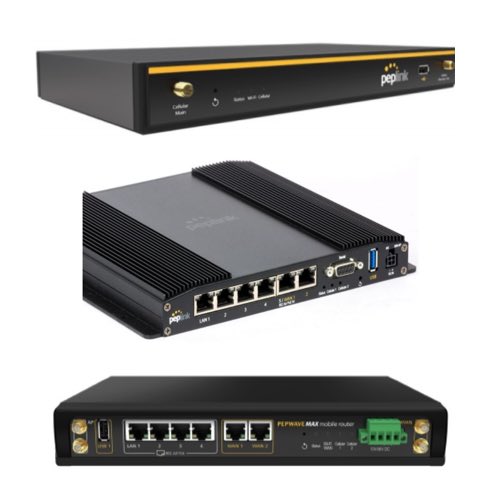Peplink Cellular Routers

Peplink cellular routers are built to ensure seamless connectivity as you travel, providing powerful and dependable solutions for both primary and backup routers across an array of networking settings. The Peplink MAX series, which includes models such as the MAX BR1, is distinguished by ruggedness and flexibility, and is widely used across mobile industries that demand reliable connectivity. Whether you're using a cellular provider as your ISP or relying on the routers at fluctuating signal locations, Peplink routers are engineered to maintain strong and stable connections. They shine in mobile applications, driving much of the network performance for fleets, first responders, and remote job sites.
As seamless connectivity backup routers, Peplink devices guarantee network redundancy and reliability. They are outfitted with such characteristics as WAN ports and Wi-Fi WAN that accommodate network source switching. These routers are designed for true mobility and used in applications where uninterrupted and dependable internet access is non-negotiable. Yet Peplink "integration" here is not simply a matter of putting the parts together: The routers are designed not only to switch but also to ensure that the data is traveling in the right way to the right places.
More Information about Peplink Wireless Cellular Gateway Routers
Peplink offers a range of rugged cellular gateway routers that can be used as primary or backup routers, providing seamless connectivity wherever you go. For businesses that require a mobile or portable internet solution, Peplink's mobile routers' setup is straightforward, and it requires no special skills to get going. From that point, you should have a workable broadband solution, whether the local conditions are optimal or not.
Peplink cellular routers deliver excellent network performance and are known for their sturdy designs. Built to handle tough mobile conditions, they offer great value through their reliability, ease of deployment, and up-to-date firmware. Whether used as primary networking devices or as contingency solutions, these routers support 24/7 operation and are ideal for business sectors that require high-performance mobile connectivity. From transportation fleets to industrial remote monitoring systems, Peplink cellular routers are trusted for their durability and "go-anywhere" connectivity.
FAQs
Does Peplink offer sturdy mobile routers cellular routers that deliver excellent value and WAN smoothing with the latest firmware?
Yes, Peplink offers sturdy mobile cellular routers that deliver excellent value and feature WAN smoothing with the latest firmware for optimized network performance.
Are Peplink cellular routers built for mobility?
Yes, Peplink cellular routers are built for mobility, providing reliable and seamless connectivity wherever you go.
Basics of Switches, Routers & Hubs
Ethernet hubs, switches and routers connect computers to networks, devices and other computers.
Ethernet hubs are the least intelligent of the three devices. They simply take any message that is received and transmits it to every other device connected to that hub. For example, if CPU 1 on a network wants to send a message to CPU 5, it will send that message through the hub.The hub will then take that message and send it out to every connected device on that hub regardless of the intended target. When CPU 5 receives that message and wants to respond, it will send its response through the hub which sends it to every connected device. Ethernet hubs do not manage any data that is sent and tend to bog down networks. They also do not offer much security for the network. For these reasons, Ethernet hubs are are being replaced with network switches.
Switches transmit data from one device to another on the same network. Unlike a hub, switches use a switch table to learn where data came from and where to send it. Switch tables store Mac addresses and device ports. By storing this data, a switch can operate more efficiently than a hub, greatly reducing the traffic within the network.
Routers transfer data between devices while learning the location of those devices within the network. They are also a junction between two or more networks. An example of this would be a home router where the home network is connected to the Internet. Another example would be when the router connects two or more networks with different business functions. In addition to connecting two or more networks, a router offers important security features that help protect the network.

